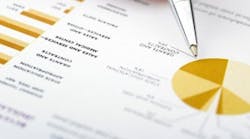PC-based HMIs can communicate easily with controllers to acquire data, store vast amounts of data, and typically provide sophisticated tools to view and analyze data. One way to get data into a PC is to use data-acquisition cards that plug directly into the PC. But for most machine and robot builders, it's a simpler and cheaper solution to acquire data through the automation system.
SEE ALSO: Product Roundups: Gather Ye Data While Ye May
"PCs have limitations in high-speed data acquisition applications because the standard PC operating environment is not time-deterministic," observes Bill Savela, PE, product manager at Delta Computer Systems. "The solution is to use dedicated hardware for deterministic I/O processing, and mate it to the PC for data archiving and display."
"Our RMC family of motion controllers is easily interfaced to PCs using industry-standard network interfaces such as EtherNet/IP," Savela adds. "We also provide drivers that enable interface to PC-based data acquisition systems using software such as National Instruments' LabView, or to custom applications written using Visual Basic or similar tools."
The controllers, Savella says, also can coordinate the switching of feedback inputs from multiple sensors, "which is especially useful when a wide measurement range necessitates the use of multiple sensors in order to get the needed resolution within various ranges."
For applications without a PC-based HMI, often the best option is to use the controller itself to collect and store data, and to transfer this data to external platforms for analysis. AutomationDirect, known for providing low-cost controllers for OEM applications, now provides higher-end controllers that can perform more-sophisticated tasks such as data logging.
"Our Productivity3000 Series controller provides data-logging capabilities standard on both CPUs," notes Jeff Payne, product manager of the automation controls group at AutomationDirect. "Simply connect a removable USB drive to the dedicated port, and fill in the blanks with the configuration software to indicate what data is to be logged and at what intervals," Payne explains. "With the controller's built-in web server, one can easily access these log files from any web browser."
Programmable automation controller (PAC)-based data acquisition often can be accomplished with a plug-in card. "Our FactoryTalk Historian ME module is embedded in the ControlLogix PAC chassis, providing reduced risk of data loss due to network or other system interruption," says Chirayu Shah, product manager at Rockwell Automation. "The module stores data in a compact flashcard locally, and connects to the plant or site historian to offload data for more persistent storage. The module collects data over the backplane from the controller, providing a historical log of activities at the machine level." Since it's a hardware module, it doesn't require any OS updates or PC maintenance.
"By collecting data at a much higher speed — 10x faster — than software-based applications, the module can provide data down to a ten millisecond scan rate," Shah concludes. "It also provides more granular data than using a traditional, network-connected plant historian."
As one might expect, PC-based controllers are a natural fit for data acquisition. "Our PACs log data based on events or time, so there's no need for a separate logging device," says Cindy Hollenbeck, vice president of sales/marketing at SoftPLC. "The data file includes time/date stamp, tag/data address, and the current value — whether it is an integer, a bit state, a floating point number or a string. The resulting data log file can be in CSV file format, or in a compressed binary format for high speed/high volume logging. Data can be logged to any drive to which the PAC has access, including the internal flash memory, a USB stick or an external drive."





